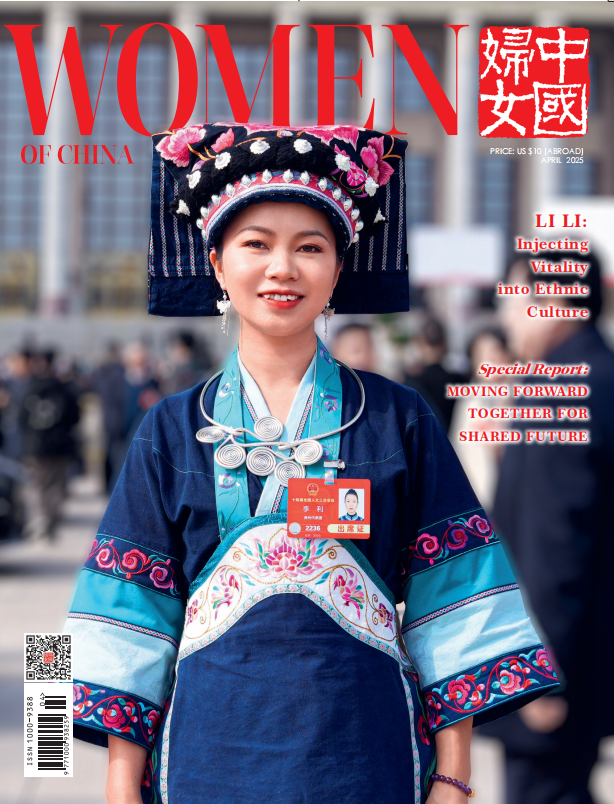Women Scientists Win Recognition

Graceful, intelligent, confident and composed, they adorned the stage in elegant attire, delivered eloquent acceptance speeches and spoke articulately in post-ceremony interviews. Their husbands and children watched proudly in the audience. This wasn't the Oscars; it was the China Young Women Scientist Award ceremony.
The event's 19th edition, held in Beijing last month, celebrated women's achievements by honoring 20 exceptional women and five outstanding teams led by women scientists.
Wang Xiaoyun, director of the supervisory committee of the award and an academician of the Chinese Academy of Sciences, announced that this year saw a record high of 825 individual candidates and 141 team candidates.
This year's winners come from various fields, such as mathematics, mechanics, physics, chemistry, materials science, biology, agronomy, Earth sciences, hydraulic engineering and pharmacology, and included representatives from universities, research institutes and enterprises. They are outstanding examples of women in science and technology in the new era, says Wang, who was a recipient of the award's third edition.
For the past 20 years, the award has witnessed the rising influence of women in science across China, showcasing their growing presence, diverse research areas and achievements.
A report on Chinese researchers from a gender perspective, released by the National Science Library of the Chinese Academy of Sciences and other departments at the end of 2022, shows that the number of women working in the discipline is growing.
In 2005, the report says, women made up 13 percent of researchers in China. According to the Ministry of Science and Technology, that number has risen to nearly 46 percent.
In 2004, as an extension and development of the For Women in Science program in China, the China Young Women Scientist Award was established jointly by the All-China Women's Federation, the China Association for Science and Technology, the China National Committee for UNESCO, and L'Oreal China. It remains the only official award for women in science and technology in China.
To date, the China Young Women Scientist Award has recognized 204 distinguished women researchers. Thirteen laureates have been elevated to become academicians of the Chinese Academy of Sciences and the Chinese Academy of Engineering.
Lan Zhenzhen, president of public affairs for L'Oreal North Asia and China, has seen firsthand the growth of women scientists in China.
She notes that women scientists are receiving more recognition and are offered better work environments, including improved equipment.
"I still remember our senior scientist, Chen Saijuan, saying how tough it was back then. Now, when we visit the laboratories of our women scientists, they are truly impressive."
She also says that women scientists are working in increasingly diverse fields that closely relate to our daily lives.
"These scientists not only excel in their scientific fields, but also take on significant social responsibilities. They engage in science education for young people, visit schools and participate in charitable activities," Lan says.
Every year, the award-winning women scientists seem to smash traditional perceptions.
"Some are also musicians who hold solo concerts. Some are adventurers who dive. And some are excellent swimmers. Their talents are truly diverse," she says.
Polygonal Warriors
All the award-winning women scientists wear multiple hats — they are not only researchers but also mentors to students, leaders of their teams and often administrative heads of their departments. Many are also mothers.
As they navigate the balance between work and life, they serve as role models and guides for the next generation of women researchers, imparting their dedication and care to their successors.
"Researchers have to be 'polygonal warriors', balancing teaching, research, management and family life. It sounds difficult, and it truly isn't easy. My 'polygon' isn't perfectly balanced," says Chen Yuli, a professor at Beihang University. "Sometimes, I feel guilty for not spending enough time with my child."
Chen excels at finding inspiration in everyday life. For example, a hedgehog's spines deter predators and cushion falls, with damage to one spine rarely affecting the others. To Chen, this discrete structure offers exceptional performance and a broad design space.
Chen's team introduced the concept of "three-dimensional pixels", using hundreds of flexible straws to create an impact-resistant material similar to a hedgehog's spines. This innovative structure provides new ideas for designing deformable aircraft and reusable impact protection systems for rockets and spacecraft.
Chen also teaches, in addition to doing research.
"At Beihang University, we believe in blending teaching with research. We learn from teaching, and we research through teaching. They complement each other," she explains.
She has her own special way of mentoring students in her research group.
"Besides our weekly meetings, once a year, we have a 'Life Chat, Dream Talk' session. It's a time for everyone to share stories and insights from their lives and studies over the past year. We keep it light, sometimes even making funny PowerPoint presentations," Chen says.
She puts her best effort into everything she does, but tends to be cautious when dealing with others.
"I usually only apply for projects when I'm confident in the research plan and sometimes even when the most critical parts are nearly done."
She believes this cautiousness is common among women researchers.
"When presenting work, women may tend to underrate themselves out of caution. While a project might deserve a score of 90, a woman presenter might only rate it at 70."
The report on the portrait of Chinese researchers from a gender perspective reveals that women researchers generally have more collaborators and larger collaborative networks than their male counterparts. Teams led by women are also larger.
Fan Xuanmei, a researcher at Chengdu University of Technology, and deputy head of the national key laboratory of geohazard prevention and geoenvironment protection, spends much of her time leading teams through rugged terrain in the wilderness. Her priority is not only completing projects but also ensuring the safety of her team.
Yet, she finds that the beauty of science and nature offers one of the most profound experiences for the human spirit. Being able to witness and understand certain aspects brings her immense satisfaction and fulfillment.
Fan changed her research focus after visiting the Wenchuan earthquake site in Sichuan Province in 2008. She decided to work to improve predictions of geological hazards caused by earthquakes because she believed it could save more lives.
Balancing motherhood and work proved tough for Fan.
"My little one woke up needing to be fed four or five times a night. For about a year, I barely slept and then had to work during the day, feeling really tired," Fan says.
She knows many women researchers face this problem. She talked about the "leaky pipeline effect" — though many women start in research, fewer make it to top positions.
As her child grew, she realized better childcare services could help more women pursue research. Taking action again like in Wenchuan over a decade ago, she joined discussions with other women scientists, suggesting improvements to childcare support.
Her years at disaster sites made her notice changes. "Some national policies changed in 2023, relaxing age limits for women in talent programs and easing worries for breastfeeding moms. More policies like these would be great," Fan says.
Photo from Women Voice
(Source: China Daily)
Please understand that womenofchina.cn,a non-profit, information-communication website, cannot reach every writer before using articles and images. For copyright issues, please contact us by emailing: website@womenofchina.cn. The articles published and opinions expressed on this website represent the opinions of writers and are not necessarily shared by womenofchina.cn.








.jpg)

 WeChat
WeChat Weibo
Weibo 京公网安备 11010102004314号
京公网安备 11010102004314号